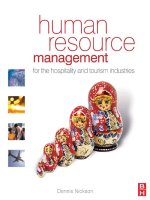perfect phrases in spanish for the hotel and restaurant industries
Bạn đang xem bản rút gọn của tài liệu. Xem và tải ngay bản đầy đủ của tài liệu tại đây (731.1 KB, 193 trang )
PERFECT
PHRASES
HOTEL and
RESTAURANT
INDUSTRIES
D
in Spanish
for the
This page intentionally left blank
PERFECT
PHRASES
HOTEL and
RESTAURANT
INDUSTRIES
D
Jean Yates
in Spanish
for the
500+ Essential Words and Phrases
for Communicating with Spanish-Speakers
New York Chicago San Francisco Lisbon London Madrid Mexico City
Milan New Delhi San Juan Seoul Singapore Sydney Toronto
Copyright © 2008 by The McGraw-Hill Companies, Inc. All rights reserved.Manufactured
in the United States of America. Except as permitted under the United States Copyright
Act of 1976, no part of this publication may be reproduced or distributed in any form or
by any means, or stored in a database or retrieval system, without the prior written
permission of the publisher.
0-07-164228-5
The material in this eBook also appears in the print version of this title: 0-07-149478-2.
All trademarks are trademarks of their respective owners. Rather than put a trademark
symbol after every occurrence of a trademarked name, we use names in an editorial
fashion only, and to the benefit of the trademark owner, with no intention of infringement
of the trademark. Where such designations appear in this book, they have been printed with
initial caps.
McGraw-Hill eBooks are available at special quantity discounts to use as premiums and
sales promotions, or for use in corporate training programs. For more information, please
contact George Hoare, Special Sales, at or (212)
904-4069.
TERMS OF USE
This is a copyrighted work and The McGraw-Hill Companies, Inc. (“McGraw-Hill”) and
its licensors reserve all rights in and to the work. Use of this work is subject to these terms.
Except as permitted under the Copyright Act of 1976 and the right to store and retrieve one
copy of the work, you may not decompile, disassemble, reverse engineer, reproduce,
modify, create derivative works based upon, transmit, distribute, disseminate, sell, publish
or sublicense the work or any part of it without McGraw-Hill’s prior consent. You may use
the work for your own noncommercial and personal use; any other use of the work is
strictly prohibited. Your right to use the work may be terminated if you fail to comply with
these terms.
THE WORK IS PROVIDED “AS IS.” McGRAW-HILL AND ITS LICENSORS MAKE
NO GUARANTEES OR WARRANTIES AS TO THE ACCURACY, ADEQUACY OR
COMPLETENESS OF OR RESULTS TO BE OBTAINED FROM USING THE WORK,
INCLUDING ANY INFORMATION THAT CAN BE ACCESSED THROUGH THE
WORK VIA HYPERLINK OR OTHERWISE, AND EXPRESSLY DISCLAIM ANY
WARRANTY, EXPRESS OR IMPLIED, INCLUDING BUT NOT LIMITED TO
IMPLIED WARRANTIES OF MERCHANTABILITY OR FITNESS FOR A PARTICU-
LAR PURPOSE. McGraw-Hill and its licensors do not warrant or guarantee that the
functions contained in the work will meet your requirements or that its operation will be
uninterrupted or error free. Neither McGraw-Hill nor its licensors shall be liable to you or
anyone else for any inaccuracy, error or omission, regardless of cause, in the work or for
any damages resulting therefrom. McGraw-Hill has no responsibility for the content of any
information accessed through the work. Under no circumstances shall McGraw-Hill and/or
its licensors be liable for any indirect, incidental, special, punitive, consequential or
similar damages that result from the use of or inability to use the work, even if any of them
has been advised of the possibility of such damages. This limitation of liability shall apply
to any claim or cause whatsoever whether such claim or cause arises in contract, tort or
otherwise.
DOI: 10.1036/0071494782
We hope you enjoy this
McGraw-Hill eBook! If
you’d like more information about this book,
its author, or related books and websites,
please click here.
Professional
Want to learn more?
The author would like to thank Gina García
for her very helpful comments.
This page intentionally left blank
vii
Contents
Introduction xi
CHAPTER 1: SPANISH BASICS 1
Greetings 1
Pleasantries 2
Family and Friends 3
The “Magic” Words 5
Telling Present Time and Using Numbers 1–12 6
Indicating Work Hours 9
Talking to More than One Person at a Time 10
Days of the Week 10
Months of the Year and Using Numbers 1–31 12
Talking About the Weather 15
Interviewing an Employee 15
Asking for References 16
Hiring an Employee 17
Scheduling 18
Discussing Salary and Using Numbers 40ϩ 19
Rates of Payment 22
Discussing Pay Periods 22
Discussing Taxes 23
Showing Appreciation for Good Work 24
For more information about this title, click here
viii
Clearing Up Confusion 25
Terminating an Employee 25
Basic Questions and Answers 27
Yes-or-No Questions 27
Information Questions 28
CHAPTER 2: ESTABLISHING POLICIES 33
Entering and Leaving the Hotel 35
Hotel Employees 37
Dress Codes and Policies for Employees 38
Equipment and Supplies 41
Setting Priorities 42
Emergency Policies 42
Safety Precautions 44
CHAPTER 3: GENERAL INSTRUCTIONS 47
Indicating Order and Repetition of Tasks 50
Indicating Locations of Things 51
Going Places and Taking Things 52
CHAPTER 4: SPECIFIC TASKS FOR
GUEST ROOM ATTENDANTS
55
Introducing the Guest Rooms 55
Tasks for Cleaning the Guest Rooms 56
Cleaning the Room and Its Contents 57
Changing the Beds 61
Replenishing Supplies in the Room 63
Contents
ix
Contents
Tasks for Cleaning the Bathrooms 64
Final Tasks 66
Interacting with Guests 68
CHAPTER 5: SPECIFIC TASKS FOR
THE LAUNDRY UNIT
71
Introducing the Work in the Laundry 71
Operating Laundry Machines 73
The Washing Machines 73
The Dryers 78
The Pressing and Folding Machines 79
Stacking and Packing Finished Items 82
Laundry Room Maintenance 82
CHAPTER 6: SPECIFIC INSTRUCTIONS FOR
KITCHEN AND FOOD SERVICE
STAFF
85
Working in the Kitchen 85
Getting Ready to Work 86
Preparing Food 87
Utensils for Preparing Food 89
Cooking 90
Baking 93
Arranging Food on Plates and Garnishing 95
Emergencies 96
Kitchen Maintenance 97
Organizing the Kitchen 98
Washing Dishes 98
Disposing of Garbage 100
x
Food Service 102
Room Service 102
Banquet Setup 105
Banquet Service 110
Banquet Cleanup 113
CHAPTER 7: SPECIFIC TASKS FOR THE INDOOR
MAINTENANCE TEAM
115
Routine Cleaning of Public Rooms 116
Tools and Equipment 118
Keeping the Hotel in Good Repair 120
Routine Tasks for the Maintenance Team 120
Special Projects for the Maintenance Team 121
Tools and Equipment 124
Pest Control 126
Appendix: Numbers 129
English-Spanish Glossary 133
Glosario español-inglés 155
Contents
xi
Introduction
I
n many parts of the United States, hotels, motels, and guest
houses are employing at an increasing rate Spanish-speaking
housekeepers, laundry workers, kitchen and food service staff,
and indoor and outdoor maintenance workers who do not speak
English. This book is designed to provide such employers with simple
phrases in Spanish that will enable them to communicate basic infor-
mation to their employees, helping to ensure that they understand
the information necessary for jobs to be done correctly, efficiently,
and safely. In learning some Spanish phrases, employers often
develop stronger working relationships with their employees, who
are generally most appreciative of this interest.
It is very common for people who do not speak each others’ lan-
guages to communicate with hand signals, gestures, or words they
may have heard others say. This may lead to a certain level of mutual
understanding, but it is certainly less than ideal, especially in a job
setting, as it often ends in misunderstandings by both parties, can
cause mishaps and bad feelings, and could even be dangerous. In this
book, employers will find key words and phrases that will help them
begin communicating with their Spanish-speaking employees in a
clear and correct manner right from the beginning. While this is not a
course in grammar or conversation, those who consistently use these
words and phrases with their employees will find that they are begin-
ning to understand and use quite a bit of Spanish, and can actually
build on this foundation to continue learning the language.
Copyright © 2008 by The McGraw-Hill Companies, Inc. Click here for terms of use.
xii
How This Book Is Organized
The phrases in this book are divided into six sections. In Chapter 1,
you will find general words and expressions that are used every day
to say such things as hello and good-bye, please and thank you, and
other common courtesies. Also in this section are the phrases that will
enable you to hire and terminate help and to explain to an employee
the general rules and policies of employment with you, including
such topics as wages, social security payments, punctuality, and so
forth. You will also find the words to help you express satisfaction or
dissatisfaction with an employee’s performance. In Chapter 2, you
will find phrases for introducing your hotel to potential employees
and establishing the basic policies regarding working there. Chapter
3 provides phrases for giving general instructions. Chapter 4 includes
specific phrases for explaining to housekeeping staff how you expect
things to be done in that department. Chapter 5 includes specific
phrases for laundry room workers. Chapter 6 provides the vocabulary
for giving instructions to kitchen and food service workers, and Chap-
ter 7 the words and phrases for indoor maintenance workers. The two
glossaries contain all the words used in the book and are arranged in
alphabetical order, the first from English to Spanish, and the second
from Spanish to English. In addition, there is a table of the numbers
from 0 to multiple millions, for handy reference.
Vocabulary Guidelines
Throughout the book there are phrases that allow for substitutable
words. When this occurs, the word that can be replaced with another
is underlined. Then one, two, or more words that could easily replace
the underlined word are presented. This feature will help you memo-
Introduction
xiii
Introduction
rize the most useful phrases, and generate an unlimited number of
useful sentences. An example is shown below:
This is a single room. Esta es una habitación sencilla.
(EH-stah es oo-nah ah-bee-tah-
S’YOHN sen-SEE-yah)
double room habitación doble
(ah-bee-tah-S’YOHN
DOH-bleh)
suite suite
(eh-SWEET)
Pronunciation Guidelines
Each phrase in Chapter 1 and Chapter 2 is printed in Spanish to the
right of its equivalent English phrase, with a guide to its pronuncia-
tion written directly underneath. The symbols used are an approxi-
mation of how the words would sound if they were written in English,
as illustrated below.
Vowels
To make a Spanish vowel sound, open your mouth and place your lips
in position, and do not move your lips until you make the next sound.
Spanish Spelling Approximate Pronunciation
a ah
e eh
i ee
o oh
u oo
xiv
To make a vowel combination, begin with the first vowel, then
move your lips into the position of the second.
ai eye
ei ay (like the ei in weight)
oi oy
ui wee
ia yah
ie yeh
io yoh
iu yoo
au ah’oo
eu eh’oo
ua wah
ue weh
uo woh
Consonants
b b
ca / co / cu kah / koh / koo
ce / ci seh / see
d (to begin a word) d
d (after a vowel) th (as in brother)
f f
ga / go / gu gah / goh / goo
ge / gi heh / hee
h silent (like the h in honest)
j h
Introduction
xv
la / le / li / lo / lu lah / leh / lee / loh / loo
al / el / il / ol / ul adl / edl / eedl / odl / udl
ll y / j
m m
n n
n (before c / g) ng (like the ng in finger)
ña / ñe / ñi / ño / ñu n’yah / n’yeh / n’yee / n’yoh / n’yoo
p p
que / qui keh / kee
r (at the beginning) rrr (trilled)
r (between vowels) d / tt / dd
bari body
beri Betty
biri beady
ora oughtta
vuru voodoo
rr rrr (trilled)
s s
t t
v b
x ks
y y / j
z s
Syllables
As a general rule, in the transcription each syllable that is printed in
lower case letters should be pronounced with the same tone and
length, and the syllable printed in capital letters should be empha-
Introduction
xvi
sized, by saying it a little louder and longer than the others. For exam-
ple, the word bueno, which means good, is represented as follows:
good bueno
(B’WEH-noh)
How to Get the Most Out of This Book
There are many ways that you can help build your Spanish
vocabulary:
• Use the pronunciation guidelines provided, but also listen to
your employees and try to copy their pronunciation.
• Customize your phrases by substituting words with other words
from the lists provided, and also with new words you may learn
from your employee. Words that are underlined can be substi-
tuted with words from the alphabetical lists provided in Part 7.
• Keep a notebook—ask your employee to say or write down
problematical words or expressions; then, if you cannot find
the word in this book, seek help from a dictionary or a bilingual
speaker.
• To learn new words from your employee, begin right away by
memorizing the following question:
How do you say _____ ¿Cómo se dice _____ en español?
in Spanish? (KOH-moh seh DEE-seh _____ en
eh-spahn-YOHL)
The words you get as answers to your question can be added to your
notebook to help you remember them.
Introduction
xvii
Introduction
Cultural Guidelines
In most Spanish-speaking countries, there are three ways to say
you: tú, to a person you generally socialize with; usted, to any other
person, including a person you work for or who works for you, and
ustedes, to two or more people whom you are talking to at the
same time. The phrases in this book are given in the usted form, and
instructions are also provided for changing these to the plural us-
tedes form. This will ensure that you are speaking to your employees
in a respectful manner that will certainly be appreciated. Employees
will also respond to you with this form.
Some Hispanic cultures have a more relaxed concept of time than
that generally accepted in the United States. You will need to make
it clear that arriving on time and on the agreed day(s), especially for
work, is very important in this country, and that if an emergency arises
that causes an employee to be late or unable to work, you expect to
be informed right away.
You may want to have some idea about the family situations of
your employees, as family is generally very important in Hispanic cul-
ture. Your workers may be supporting a number of family members
both here and back home. Be sure to make clear to those who work
for you what your policies are for time off for family emergencies and
celebrations as well as for personal illness.
This page intentionally left blank
1
Chapter 1
Spanish Basics
E
xchanging pleasantries and greetings with your Spanish-
speaking employees is a great way to begin to build a stron-
ger working relationship.
Greetings
Hello. Hola.
(OH-lah)
Good morning. Buenos días.
(B’WEH-nohs DEE-ahs)
Good afternoon. Buenas tardes.
(B’WEH-nahs TAR-thess)
Good evening. Buenas noches.
(B’WEH-nahs NOH-chess)
Good night. Buenas noches.
(B’WEH-nahs NOH-chess)
Good-bye. Adiós.
(ah-TH’YOHS)
Copyright © 2008 by The McGraw-Hill Companies, Inc. Click here for terms of use.
2
Perfect Phrases in Spanish for the Hotel and Restaurant Industries
See you later. Hasta luego.
(AH-stahl WEH-goh)
Have a nice day. Que le vaya bien. (lit: May all go well
for you—to someone who is
leaving)
(keh leh bah-yah B’YEN)
In Spanish sometimes you need to change your greeting, depend-
ing on whether you are speaking to a male or a female and also when
you speak to several people together. In the examples below, you’ll
see four ways to say “Welcome”:
Welcome. (to a male) Bienvenido.
(b’yen beh-NEE-thoh)
Welcome. (to a female) Bienvenida.
(b’yen-beh-NEE-thah)
Welcome. (to an all-male or Bienvenidos.
mixed group) (b’yen-beh-NEE-thohs)
Welcome. (to an all-female group) Bienvenidas.
(b’yen-beh-NEE-thahs)
Pleasantries
Just as “Hi, how are you?” is usually the first thing we say to each other
in English, its equivalent in Spanish is the most usual greeting.
How are you? ¿Cómo está?
(KOHM-weh-STAH)
3
Spanish Basics
To say the same thing to more than one person, just add n to está,
making están:
How are you (all)? ¿Cómo están?
(KOHM-weh-STAHN)
Here are some stock answers:
Fine, thank you. Bien, gracias.
(B’YEN GRAHS-yahs)
So-so. Regular.
(reh-goo-LAHR)
Más o menos. (lit: more or less)
(MAHS oh MEH-nos)
Not well. Mal.
(MAHL)
Family and Friends
”Family first” is an important concept in Hispanic culture, and asking
about the health of family members is one way of showing that you
understand and appreciate this.
Use the following formula to ask about one person:
How is your mother? ¿Cómo está su mamá?
(KOHM-weh-STAH soo mah-MAH)
4
Perfect Phrases in Spanish for the Hotel and Restaurant Industries
Just substitute any of the following words to ask about others:
father papá
(pah-PAH)
husband esposo
(eh-SPOH-soh)
wife esposa
(eh-SPOH-sah)
sister hermana
(ehr-MAH-nah)
brother hermano
(ehr-MAH-noh)
son hijo
(EE-hoh)
daughter hija
(EE-hah)
To inquire about more than one person at a time, just add s to su,
another s to make the word plural, and add n to está:
How are your parents? ¿Cómo están sus papás?
(KOHM-weh-STAHN soos pah-PAHS)
children hijos
(EE-hohs)
daughters hijas
(EE-hahs)
sisters and brothers hermanos
(ehr-MAH-nohs)
sisters hermanas
(ehr-MAH-nahs)
5
Spanish Basics
While we’re on the subject of people important to us, let’s include
a few more who we can’t do without:
friend (male) amigo
(ah-MEE-goh)
friend (female) amiga
(ah-MEE-gah)
boyfriend novio
(NOH-b’yoh)
girlfriend novia
(NOH-b’yah)
boss (male) patrón / jefe
(pah-TROHN) / (HEH-feh)
boss (female) patrona / jefa
(pah-TROH-nah) / (HEH-fah)
neighbor (male) vecino
(beh-SEE-noh)
neighbor (female) vecina
(beh-SEE-nah)
These words can also be made plural, by adding s (or es in the
case of patrón). (It’s probably not a good idea to make novio or
novia plural.)
The “Magic” Words
These are the essential words for showing courtesy and respect.
Memorize these right away.









